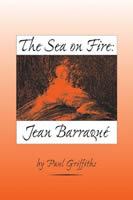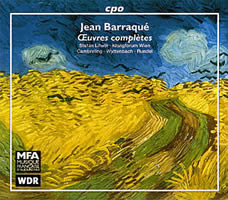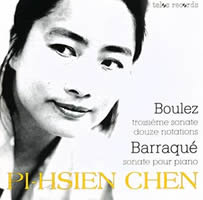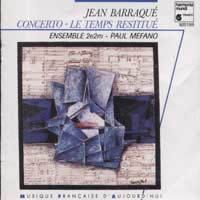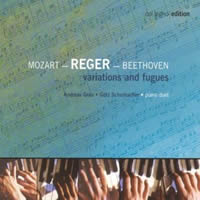No Longer and Not Yet
|
Walt Mundkowsky [September 2004.]
The Sea on Fire: Jean Barraqué Some of us have hobbyhorses; French serialist Jean Barraqué (1928-1973) is one of mine. Like many, I discovered him from André Hodeir’s 1961 book, Since Debussy: A View of Contemporary Music. Hodeir famously compared Barraqué’s Piano Sonata (not yet done in public at the time) to the Grosse Fuge — a less ridiculous edict in light of Beethoven’s piano-four hands arrangement (Op. 134). I never found the Loriod record Hodeir knew (it was taped in tiny bites and goes much too fast), and caught Claude Helffer’s 1969 LP as a reissue (Astrée AS 36) after Barraqué’s death. But Roger Woodward’s demonic portrayal (10-22-72, with the composer present) was a life-altering experience. Barraqué had a dark image of the creative act — “… art must evolve toward death, must achieve itself through ‘endless unachievement’” — and finished only six compositions (and an electronic étude) before a stroke took him at 45. Acknowledged as the tragic poet of the serialist bunch, his day may yet come. I was hoping for a lot from this book. Paul Griffiths has produced fine Barraqué entries in modern-music reference volumes, as well as notes for cpo’s compleat works (999 569-2, 3 discs). With access to the testimony of seemingly everyone Barraqué might’ve met (plus original research), Griffiths presents much that’s new. Ravel patted four-year-old Jean on the head and Barraqué grew up to detest his music (though not for that reason). An encounter at 12 with Schubert’s Unfinished Symphony set him on the road to composing. Beethoven was soon to follow and the two would remain lifelong models, defining Barraqué as unlike his serialist colleagues. Indeed, Griffiths lends him a Schubertian cast — small, well-dressed, nearsighted, sickly. Messiaen’s course at the Conservatoire, where Barraqué absorbed the serialist doctrine in 1948, is outlined with crisp details and puckish wit — “The stage was empty, and Boulez had spotted his place there — not in a bit part.” Relationships between Barraqué and another composer, Karel Goeyvaerts, and then philosopher Michel Foucault contribute important ideals. And Foucault would steer Barraqué’s musical path as nobody else did. Hodeir made an inarguable point, that the Piano Sonata (1950-52) has a desperate finality rare in a composer who’s 24. Séquence, a song cycle Barraqué drafted before working on the Sonata, reached its final form in 1955, when Foucault introduced him to the Nietzsche poems. The composer regarded it as his Op. 1. Foucault went on to present Barraqué with his life’s work, Hermann Broch’s novel The Death of Virgil. Its tone (lengthy, poetic and forbiddingly dense) held immense appeal, the subject even more so: Nearing death, Virgil is deciding whether to destroy his Aeneid. “I was waiting for The Death of Virgil without knowing it,” Barraqué said. He embarked on his own “endless unachievement” — putting a 473-page book to music. Three large panels got completed, also a Concerto in 1968 that sits somewhat apart. Aldo Bruzzichelli, Barraqué’s publisher, supposedly confined him in a Florence hotel on separate occasions to bring the last two of those to term. Nothing new surfaced from his last five years. Jazz pianist Paul Bley once told a college class, “One has to be the greatest salesperson in the world to sell something to somebody that they have no idea that they need or want,” a skill Barraqué lacked to an almost comical extreme. Griffiths doesn’t duck the “great way of alienating [his] friends” Barraqué had, nor his problems with “most of those who could have helped” secure performances. The Piano Sonata will serve. Paul Jacobs, a wonderful choice, disliked Barraqué so much he refused even to consider it. David Tudor thought its notation faulty and couldn’t envision working out “things that I must presume are errors.” (It had taken Barraqué two years to get the score to him.) Elisabeth Klein also requested a copy but was ignored. She got the Bruzzichelli edition when it came out in 1966 and gave the world premiere without realizing it, in a Copenhagen concert the year after. (Barraqué did not attend.) Helffer wasn’t close to the composer, but he delivered it on French Radio, made the album and twice played it live, all in 1969 — 17 years after the fact. Curiously, Griffiths writes in the second person, as if addressing Barraqué. The conceit of course slumps when Music Appreciation 101 pops out (“Serialism had been developed by Schoenberg in the early twenties as a method of …”). Such paragraphs cause concern that Griffiths meant to turn in a non-specialist book, which leads to my major gripe — how he covers the music. There’s no attempt at close analysis; he narrates a work’s happenings in grey non-technical prose. And given the questions with Barraqué’s scores, not getting any samples of them is indefensible. The account of the Piano Sonata’s progress occupies two pages, within general remarks; Richard Toop’s notes for Woodward’s recording (on EMI EMSP 551) are much more helpful. Toop later devoted 50 pages to Brian Ferneyhough’s 14-minute Lemma-Icon-Epigram (in Perspectives of New Music 28/2), so Griffiths is far from pronouncing the last word. I’m glad to have this book, smudges and all. It’s not the definitive tome I was looking for, but it has plenty of meat for Barraqué enthusiasts and scholars to digest. (The title derives from the Broch novel’s final lines.) Recordings
Not much to choose from, alas. The cpo brick is essential, and cheaper than it was at first. It’s a quite assured run-through of music the superb Klangforum Wien likely hadn’t done before or since. Its Piano Sonata is dreadful, though. Go for Herbert Henck’s (ECM New Series 1621) or Pi-hsien Chen’s (telos tls 006). Henck subjected the score to a remarkable scrutiny; his notes read like a detective story. The “grandiloquence” Barraqué spoke of infuses Henck’s long paragraphs and stretched pauses. Chen’s take isn’t inferior. She opens the published edition and lets ’er rip. In 1987 Harmonia Mundi put out a disc (HMA 1905199) of the Concerto and Le temps restitué, the Broch item Barraqué started first. The French sonorities are a treat, even in a less-than-ideal soundstage. This is still available via Amazon’s Euro sites. I’d celebrate discs of the Helffer and Woodward performances, or from any of the current crop who’ve given the Sonata memorably in public — Marino Formenti, Nicolas Hodges, Marilyn Nonken, Ian Pace. Also, Barraqué’s favorite soprano, Josephine Nendick, can be heard on a 1969 LP (Astrée AS 75) containing Séquence plus Chant après chant (1966). Add it to the wish list.
Beethoven reacted angrily (as per usual) when his publisher went behind his back to get a piano-four hands version of the Grosse Fuge, and he took on the task himself. I prefer the recasting to the string-quartet original. The counterpoint is clearer, as is the Beethovenian snarl. Jörg Demus and Norman Shetler’s traversal has had a long life — on an Eterna LP (8 26 863), then in DG’s 1970 Beethoven Edition. It’s presently buried in their eight-disc box (4537332) of Beethoven’s miscellaneous piano music. Of the single CDs featuring it, col legno’s (WWE 1CD 20108) is an easy pick. Andreas Grau and Götz Schumacher are a dashing team, and the program (“variations and fugues”) shows thought. (Full review to follow.) Griffiths concludes with grace — Barraqué’s six opera “have all the qualities of greatness except public acknowledgement.” Amen to that.
[More Walt Mundkowsky]
[Previous Article:
Schoenberg’s “Mis-Handel-ing" and Other Curiosities]
[Next Article:
Random Noise 8: You Are an Audiophile]
|
